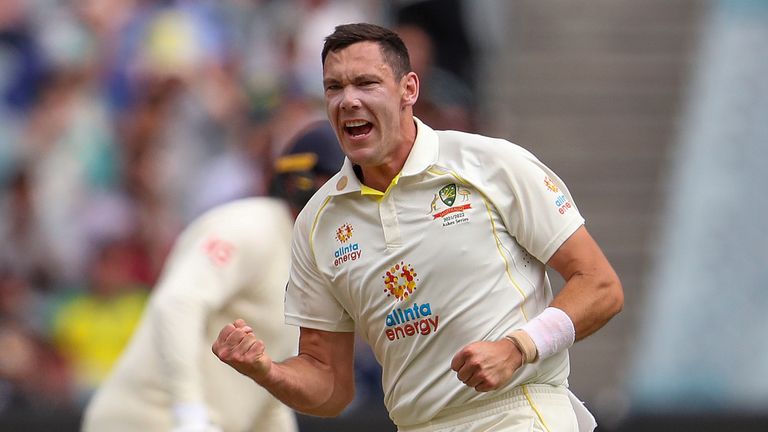
Australia’s ‘fourth’ seamer, a late developer who has enjoyed a remarkable start to his Test career, could be the dangerman as Australia seek Jason Gillespie-like heroics to seal a rare series win in India.
There is no real secret to winning Test matches in India if you’re a touring side. The first task, always easier said than done, is to see off the considerable threat likely to be posed by India’s spinners. If you can somehow do that, then your bowlers also need to do their part, on pitches that usually don’t provide the bounce or extravagant seam movement that can often trouble Indian batsmen when they venture overseas.
Since man went to the moon in 1969, Australia have won just two series in India. In the first, a few months after one small step for man and a giant leap for mankind, Ashley Mallett – an off-spinner nicknamed Rowdy – took more wickets (28) than the celebrated duo of Erapalli Prasanna (26) and Bishan Singh Bedi (21), at a better average and strike-rate too.
More than a generation later, in 2004, it was India’s Anil Kumble (27) and Harbhajan Singh (21) that topped the wicket-taking charts, but the most outstanding bowler in a series that also featured two titans in Shane Warne and Glenn McGrath was Jason Gillespie, whose 20 wickets came at a tremendous average of 16.15. It was his 9-80 in Nagpur, on a mysteriously green-tinged pitch that gave Australia the decisive victory in a series that finished 2-1 in favour of the visitors.
Along the way, there have been other unexpected star turns too. It was the unheralded Michael Kasprowicz that took 5-28 to give Australia a consolation victory in Bangalore in 1998. His dismissals of Sachin Tendulkar, who had made a magical 177 in the first innings, and Mohammed Azharuddin broke the game open, and Australia transformed a 24-run first-innings deficit into an eight-wicket win.
When Australia last toured, in early 2017, India opted for a rank turner in Pune to start the series. But with Steven Smith riding his luck to score a magnificent hundred, it was an opposition spinner that ran amok. Steve O’Keefe had identical figures of 6 for 35 in both innings as India were humiliated.
That India’s batsmen then kept O’Keefe to just seven wickets (for 372) in the remaining three Tests was a huge factor in their come-from-behind victory. That was the series in which Josh Hazlewood, Mitchell Starc and Pat Cummins – making a return to Test cricket more than five years after a remarkable debut in South Africa – were kept to just 22 wickets in 14 bowling innings, and where the outstanding fast bowler on view was India’s Umesh Yadav.
Yadav’s 17 wickets came at an incredible strike-rate of 45.5, and his outfoxing of Smith with a marvellous slower ball was the vital intervention in India’s thrilling series-squaring win in Bangalore. Throughout the series, Yadav posed uncomfortable questions with new ball and old, getting both conventional and reverse swing at genuine pace.
His performances back then are a very good reason why India can’t afford the slightest bit of complacency as they head into the first Test in Nagpur. Australia may not be greeted with the green seamer that Gillespie made hay on nearly two decades ago, and they may be without the injured Hazlewood and Starc, but they still possess a bowling attack more than capable of putting India’s misfiring top order under scrutiny.
Much of the attention will justifiably be on Cummins, who has established himself in the six years since that comeback as the five-day format’s pre-eminent pace bowler. His numbers – 214 wickets at 21.25 – are comparable with the greatest in the game’s history, and he is relentless in the same way that McGrath once was.
India will also not underestimate Nathan Lyon, who’s marginally ahead of R Ashwin (460 wickets to 449) in the race to become only the second off-spinner to take 500 in Tests. Neither will get anywhere close to Muttiah Muralitharan’s unbreakable record of 800 wickets, but Lyon, who has 34 wickets from seven Tests in India, has all the skills to take advantage should India risk preparing another raging turner.
But it’s a third individual that India should be especially wary of. Scott Boland didn’t make his Test debut till he was nearly 32, but has since grabbed his chances. He has 28 wickets from his six Tests, including a once-in-a-lifetime spell of 6 for 7 on debut as England were crushed in the Boxing Day Test of 2021. Only once in 12 innings has Boland gone wicketless, and his bustling style and ability to move the ball should come into play on pitches where reverse swing is likely to be a factor.
There is also the 22-year-old Todd Murphy to consider. It would be a surprise if Australia went into the first Test with two off-spinners, but those in the know in Australian cricket rate Murphy highly, and believe he has the repertoire to make an impact if given a chance. India’s batting stalwarts of the past decade – Virat Kohli and Cheteshwar Pujara – have struggled in home Tests in recent times and with Rohit Sharma not having played the longer format since last March, Cummins and his team will scent weaknesses they can exploit.
That 2017 series was one of the best played on Indian soil, easily comparable with the 2001 epic for its ebb and flow and reversals in fortune. In the end, it needed a stand-in captain, Ajinkya Rahane, and a new impact bowler, Kuldeep Yadav, to seal the series in Dharamsala.
Australia are pretty much assured of a place in the World Test Championship final. India still have it all to do to pencil in their entry. The core group on both sides is still largely the same, and it’ll be fascinating to see which team blinks first.




